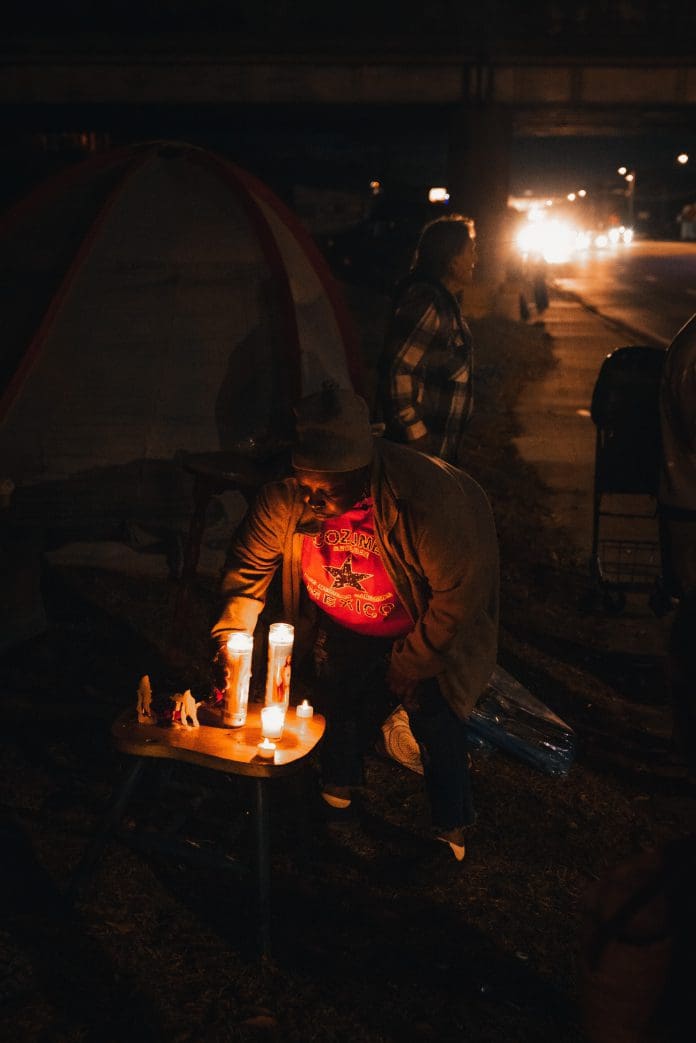How do you touch the lives of hundreds of people when everything you own fits in the space of a tent and a shopping cart? Friends say for Betty Scott, the answer was love. After the death of a woman who experienced homelessness, community members are remembering a person who had little, but gave so much.
A group of about a dozen people are gathered on the sidewalk at the edge of Lake Bradford Road just past the overpass. They’re surrounding the tent Betty Scott called home. As cars pass, many honk and those gathered yell “blow the horn for Betty!”
Candles burn on a broken wooden chair as the group sings “Lean on Me.”
Betty was a fixture on Lake Bradford Road. Evelyn Manning lives in the neighborhood. She says Betty lived near the McDonald’s and Circle K at the end of Lake Bradford Road back in 2014. Since then, she’s been moving south down the road until recently she took up a spot under the bridge, earning herself the nickname “The Lady Under the Bridge.” Finally she set up her tent, couch, lounge chair and small table right beside it.
Food and shelter are important, but what’s often forgotten is love.
“I’d try to get her to get off the streets and take her to a shelter or somewhere,” says Manning who brought Betty warm food a few times a week. “She didn’t want to go. She’d say, ‘I’m fine. I’m fine.’”
Lisa Ellis also lives in the neighborhood. Over time, she says she and Betty became best friends. She says services like food or shelter, or clothing are nice, but the thing people like Ms. Betty need most is love.
“It’s one thing to give food. It’s another thing to sit and touch and talk. And I tried to give her that touch, that talk. I laid on the ground with her,” Lisa says.
“She never judged,” Lisa says. “She took people for who and what they were and that’s what made her so special to me.”
Lisa Ellis
Lisa says she’s facing the final stages of liver disease, but caring for Betty gave her a purpose.
“I met her a year ago when I moved into the neighborhood, and I was walking to the store one day and she was sitting in the chair crying, and I stopped and asked her what was wrong and something had happened and she was very sad and we got very close,” Lisa says. “Since then, I would check on her. I would set my alarm for 2 in the morning, 4 in the morning and six in the morning to check on her and make sure nobody bothered her…
At six Lisa would sit in a small wooden chair next to Betty’s upholstered recliner and they’d take their morning coffee together.
…She helped me and I helped her.”
Lisa says she has lived through her own struggles including recovery from addiction and now facing a terminal illness. In the past, she felt she had to fight those battles alone. Then she met Betty. Betty gave her friendship and love.
“She never judged,” Lisa says. “She took people for who and what they were and that’s what made her so special to me.”
Lisa isn’t the only one who thought Betty was special. Throughout the candle light vigil to remember Betty’s life several people stopped as they walked by—asking after Betty or sharing a kind word. One passerby learned of Betty’s death in that moment and was overcome with tears. On a social media post about the “Lady Under the Bridge” more than 350 people have commented sharing their own stories.
“She touched so many people that we don’t even know,” Manning says.
Later this month, the Big Bend Continuum of Care will begin its Point in Time survey. It’s a federally required attempt to count the number of people in the community who are experiencing homelessness to get an understanding of who the unhoused people in our community are and what sort of help they might need.
9(MDA4MzU1MzUzMDEzMTkyMzAwMzY5MjY1Mw004))
9(MDA4MzU1MzUzMDEzMTkyMzAwMzY5MjY1Mw004))


